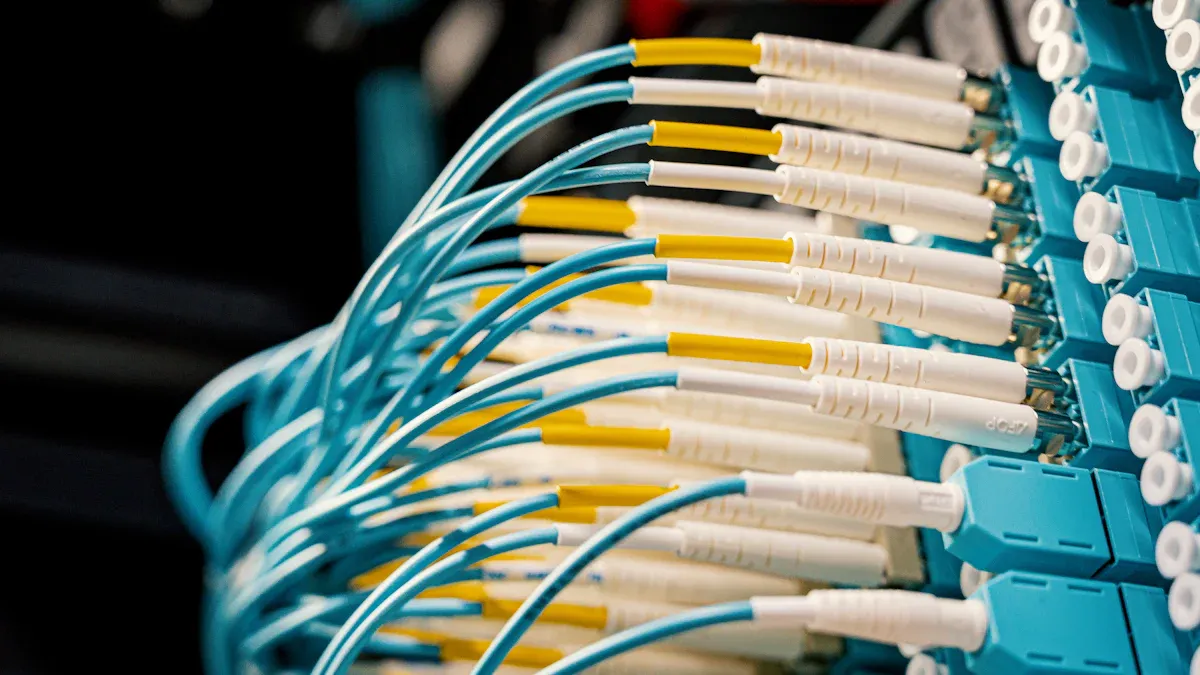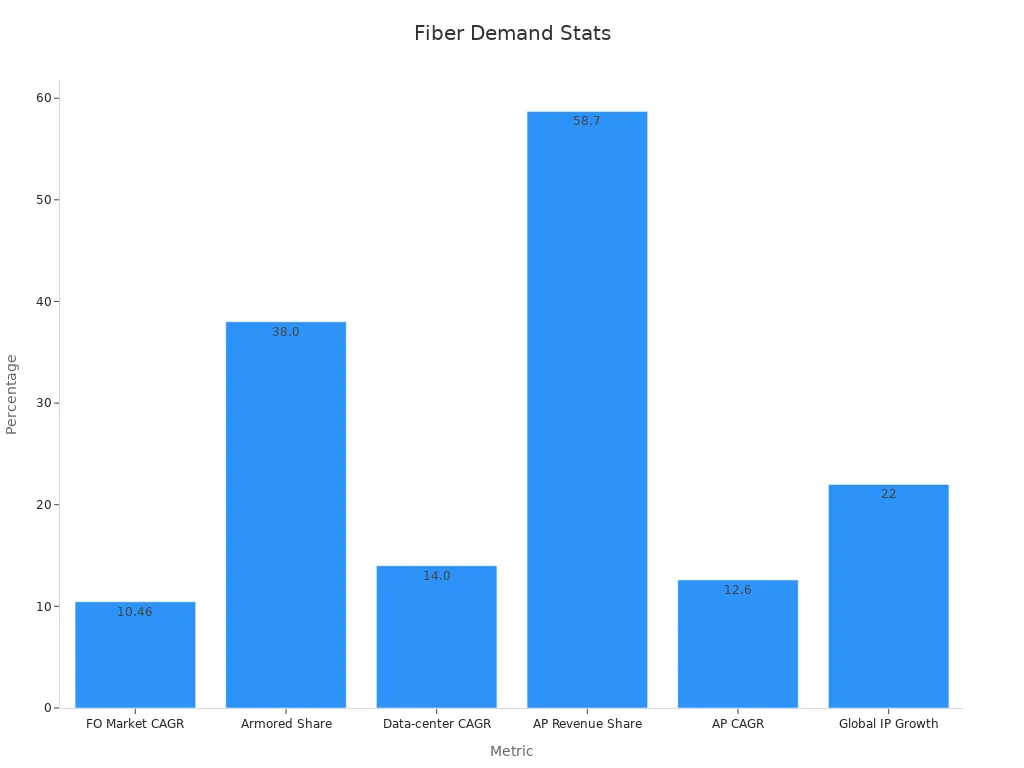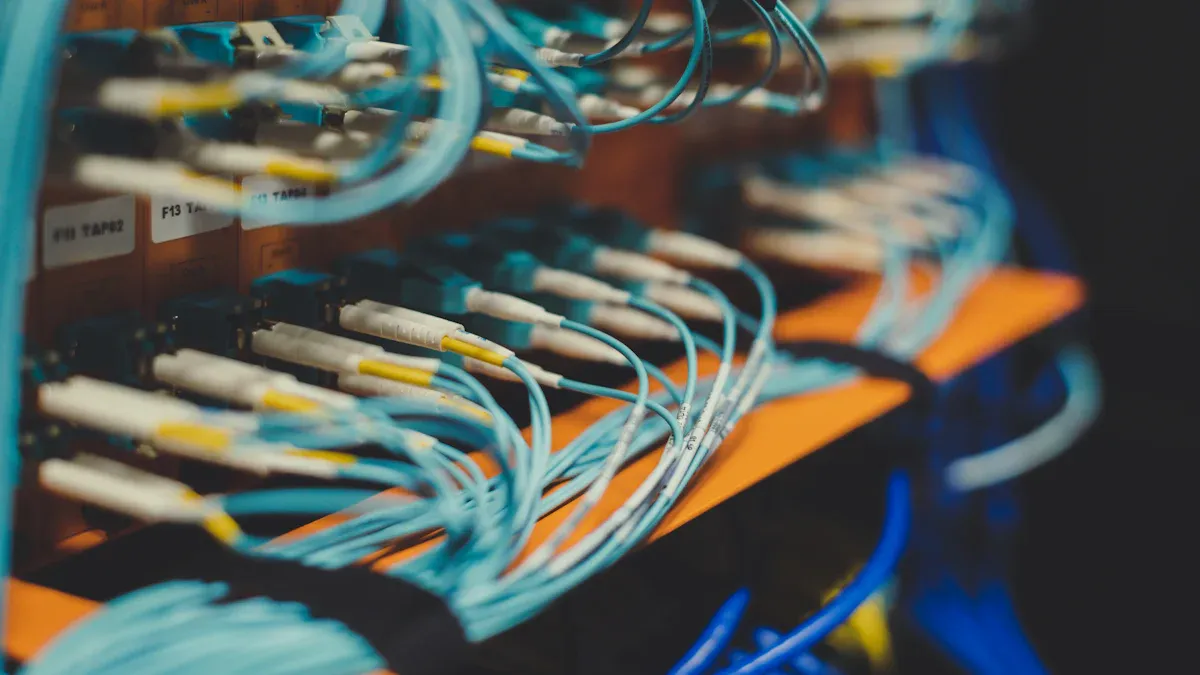
You see new demands for speed, security, and reliability in modern networks. Indoor multi-core armored fiber optic cable lets you send more data at once and protects against damage in busy spaces. Market growth shows strong preference for these cables.

You can explore different types of indoor multi-core armored cables to fit your needs. When you decide to buy indoor multi-core armored cable, you gain durable, high-speed connections for smart buildings and automation.
Key Takeaways
- Indoor multi-core armored fiber optic cables carry more data through one cable while protecting against damage, making networks faster and more reliable.
- The cable’s strong layers resist bending, crushing, and interference, ensuring safe and stable connections in busy indoor spaces.
- These cables save space, reduce installation time, and support advanced technology, making them ideal for smart buildings, data centers, and future-ready networks.
Indoor Multi-Core Armored Fiber Optic Cable: Definition and Structure

What Makes a Cable Multi-Core and Armored
You can recognize a multi-core fiber optic cable by the number of optical fibers it contains. Each core acts as a separate path for data, so you can transmit more information at once. In 2025, you see indoor multi-core armored fiber optic cable designed to meet the needs of smart buildings and high-speed networks. The “armored” part means the cable has extra layers that protect it from physical damage. These layers help the cable resist bending, crushing, and even rodent bites. You find that industry standards, such as ANSI/ICEA S-83-596 for indoor cables, set the rules for how many cores a cable can have and how strong the armor must be. These standards also require flame resistance and mechanical strength, making sure your cable works safely and reliably inside buildings.
Key Components: Aramid Yarn, Metal Hose, Outer Jacket
You can break down the structure of an indoor multi-core armored fiber optic cable into several key parts. Each part plays a special role in protecting the cable and keeping your network running smoothly.
| Component | Description |
|---|---|
| Tightly packaged optical kevlar | Gives the cable strong tensile resistance, so it can handle pulling and stretching. |
| Metal hose | Shields the cable from compression, bending, and rodent bites. |
| Metal braid | Adds protection against twisting forces. |
| Outer jacket | Made from PVC or flame-retardant materials like LSZH, it guards against chemicals and wear. |
| Aramid yarn | Used for flexibility and extra strength, especially in indoor environments. |
| Single armor | Lacks metal braid, suitable for less demanding indoor spaces. |
| Double armor | Combines metal hose and braid for maximum strength and compression resistance. |
You see that these components work together to create a cable that is both tough and flexible. Performance tests show that aramid yarn and metal hose give the cable high tensile strength (up to 750 Newtons short term) and strong crush resistance (up to 1000 Newtons short term). The outer jacket keeps the cable safe from solvents and daily wear, while flame-retardant materials meet strict safety codes.
How Structure Enhances Indoor Performance
You benefit from the advanced structure of indoor multi-core armored fiber optic cable in several ways. The multi-core design lets you send more data through a single cable, which saves space and reduces installation time. The armored layers protect the cable from bumps, bends, and other hazards you find in busy indoor spaces. This means your network stays reliable, even in high-traffic areas.
- Attenuation levels stay low (below 0.25 dB/km at 1550 nm), so you get clear signals over long distances.
- The cable can survive high mechanical stress, passing proof tests up to 100 kpsi.
- Advanced shielding materials block electromagnetic interference, keeping your data safe and stable.
- The cable works in a wide temperature range, from -20°C to +60°C, so you can use it in many indoor environments.
Tip: When you choose indoor multi-core armored fiber optic cable, you get a solution that supports high data rates, resists damage, and meets strict safety standards. This makes it ideal for smart offices, data centers, and automated buildings.
You can trust that every part of the cable, from the aramid yarn to the outer jacket, works together to deliver the durability and performance your modern network needs.
Performance Benefits and Comparisons in 2025
Protection Against Physical and Environmental Hazards
You want your network to stay strong, even when faced with tough conditions. Indoor multi-core armored fiber optic cable gives you that protection. The armored layers shield the fibers from crushing, bending, and even rodent bites. You can trust these cables to keep working in busy offices, schools, or factories.
Researchers have studied how cables perform during earthquakes and other disasters. They found that cables with strong insulation and armor, like XLPE, suffer less damage than older types. Liquefaction, which happens when the ground shakes and turns soft, causes the most harm to buried cables. However, cables with advanced armor show very low repair rates in areas without liquefaction. Lateral spreading, or sideways ground movement, does more damage than just sinking. These findings help you see how important strong cable design is for safety and reliability.
You also get peace of mind from the cable’s ability to block electromagnetic interference. The outer jacket and metal hose work together to keep your data safe from outside signals. This means your network stays stable, even in places with lots of electronic devices.
Advantages Over Outdoor and Single-Core Cables
You might wonder why you should choose indoor multi-core armored fiber optic cable over other types. The answer lies in the unique benefits you get for indoor use.
- You save space because one cable can carry many data streams at once.
- You reduce installation time and cost since you need fewer cables for the same job.
- You enjoy better protection against physical damage, which is common in indoor spaces with lots of people and equipment.
- You get higher data speeds and more reliable connections compared to single-core cables.
Outdoor cables often focus on weather resistance, but indoor cables need to handle different challenges. You face risks like accidental bumps, tight bends, and exposure to cleaning chemicals. The armored design of indoor multi-core cables meets these needs perfectly.
Application Solutions for Modern Indoor Networks
You can see the real-world value of indoor multi-core armored fiber optic cable in many modern projects. Here are some examples:
- A large university campus upgraded its network using these cables. The result was faster internet and better connections across many buildings.
- A city construction project used these cables to link commercial properties. The cables’ flexibility and strength helped finish the project on time, even with space limits and tough conditions.
- A remote mining site installed these cables to keep communication running smoothly. The cables reduced downtime and made the site safer by improving data flow between the mine and headquarters.
You can use these cables in smart buildings, data centers, hospitals, and factories. They help you build networks that are fast, secure, and ready for the future. When you choose indoor multi-core armored fiber optic cable, you get a solution that supports advanced technology and keeps your business running smoothly.
Tip: You can rely on these cables to handle the demands of automation, cloud computing, and high-speed internet in any indoor setting.
You gain strong protection and high-speed performance with indoor multi-core armored fiber optic cable.
- Multiple layers resist damage and moisture.
- Fast data rates up to 100 Gbps support modern needs.
- Easy installation and cost savings help you build future-ready networks.
These cables prepare your network for tomorrow’s digital demands.
FAQ
What is the main benefit of using multi-core armored fiber optic cables indoors?
You get more data channels in one cable. This saves space and boosts your network speed. The armor protects your cables from damage.
Can you install these cables in tight spaces?
Yes. You can bend and route these cables easily. The flexible armor and compact design help you fit them in small areas.
How do these cables improve network security?
You gain extra protection from physical tampering. The armored layers make it hard for anyone to access or damage the fibers.
By: Consult
Tel: +86 574 27877377
Mb: +86 13857874858
E-mail: henry@cn-ftth.com
Youtube: DOWELL
Pinterest: DOWELL
Facebook: DOWELL
Linkedin: DOWELL
Post time: Jun-25-2025
